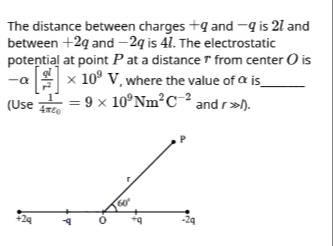Question
Question: The distance between charges +q and -q is 2l and between +2q and -2q is 4l. The electrostatic potent...
The distance between charges +q and -q is 2l and between +2q and -2q is 4l. The electrostatic potential at point P at a distance r from center O is −α[r2ql]×109 V, where the value of α is ______. (Use 4πϵ01=9×109Nm2C−2 and r≫l).

27
Solution
The problem asks us to find the electrostatic potential at point P due to a system of four charges placed along the x-axis. We are given the positions of the charges relative to the origin O, and the coordinates of point P in polar form (distance r and angle θ=60∘). We are also given the condition r≫l, which suggests using a multipole expansion for the potential.
Let the charges and their positions be:
- Charge Q1=+2q at x1=−2l
- Charge Q2=−q at x2=−l
- Charge Q3=+q at x3=+l
- Charge Q4=−2q at x4=+2l
The electrostatic potential V at a point (r,θ) due to a system of charges Qi located at positions xi along the x-axis, for r≫xi, can be expressed using the multipole expansion: V(r,θ)=4πϵ01[r∑Qi+r2(∑Qixi)cosθ+2r3(∑Qixi2)(3cos2θ−1)+O(1/r4)]
Let's calculate the multipole moments:
-
Monopole moment (Total charge): ∑Qi=(+2q)+(−q)+(+q)+(−2q)=0
-
Dipole moment: ∑Qixi=(+2q)(−2l)+(−q)(−l)+(+q)(l)+(−2q)(2l) =−4ql+ql+ql−4ql =−8ql+2ql=−6ql
-
Quadrupole moment: ∑Qixi2=(+2q)(−2l)2+(−q)(−l)2+(+q)(l)2+(−2q)(2l)2 =(+2q)(4l2)+(−q)(l2)+(+q)(l2)+(−2q)(4l2) =8ql2−ql2+ql2−8ql2=0
Now, substitute these values into the potential expansion. Since θ=60∘, we have cosθ=cos60∘=1/2. Also, 3cos2θ−1=3(1/2)2−1=3(1/4)−1=3/4−1=−1/4.
Substituting the calculated moments and cosθ into the potential formula: V(r,60∘)=4πϵ01[r0+r2(−6ql)(1/2)+2r3(0)(−1/4)] V(r,60∘)=4πϵ01[−r23ql]
We are given that 4πϵ01=9×109 Nm2 C−2. So, V=(9×109)[−r23ql] V V=−27[r2ql]×109 V
The problem states that the electrostatic potential at point P is −α[r2ql]×109 V. Comparing our calculated potential with the given form: −27[r2ql]×109 V=−α[r2ql]×109 V
From this comparison, we can see that α=27.
The final answer is 27.
Explanation of the solution:
- Identify charges and their positions from the diagram.
- Use multipole expansion for potential at a distant point (r≫l).
- Calculate monopole, dipole, and quadrupole moments of the charge distribution.
- Monopole moment (∑Qi) = 0.
- Dipole moment (∑Qixi) = -6ql.
- Quadrupole moment (∑Qixi2) = 0.
- Substitute these moments and the given angle (θ=60∘) into the potential formula.
- The potential simplifies to V=4πϵ01[−r23ql].
- Substitute the value of 4πϵ01=9×109.
- Compare the resulting potential expression with the given form −α[r2ql]×109 to find α.
